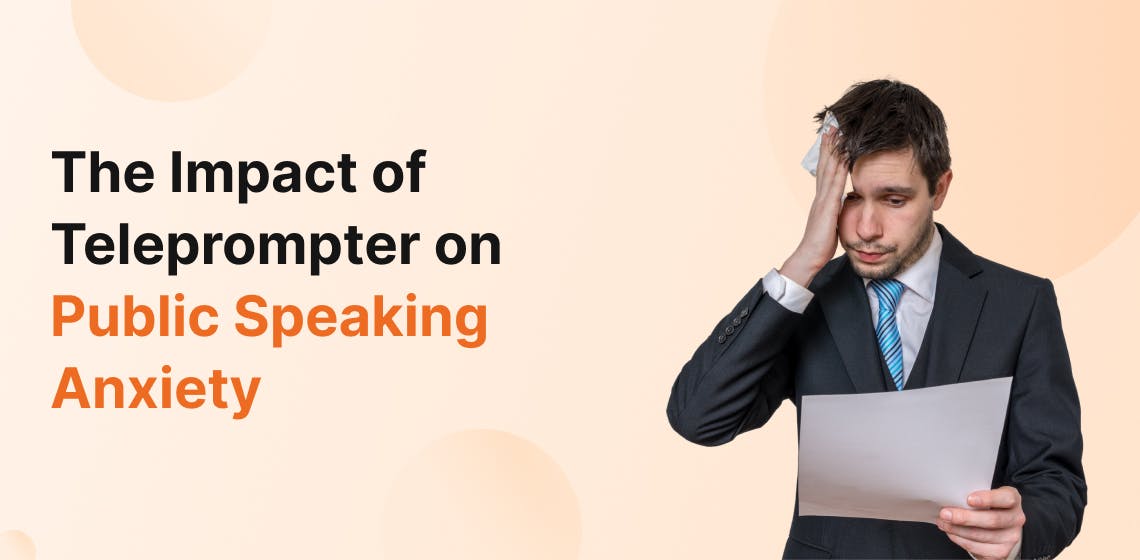
Have you ever encountered someone whose voice starts fumbling or whose legs start shaking while speaking to a group?
Well, public speaking is a common source of anxiety for many individuals.
The fear of forgetting lines, losing your train of thought, or facing an unresponsive audience can lead to heightened stress levels and negatively affect your performance.
However, technology, specifically teleprompters, offers a solution to mitigate these anxieties.
In this blog post, we’ll explore the impact of teleprompters on public speaking anxiety and practical tips for using them. Additionally, we'll see why teleprompters are essential for anyone looking to improve their speaking or presentation skills.
Let’s start by understanding what public speaking anxiety is.
Public speaking anxiety, often referred to as glossophobia, is the fear of speaking in front of an audience.
It’s a form of social anxiety that affects millions of people worldwide. While some individuals experience only mild nervousness before speaking, others may face crippling fear that affects their ability to communicate effectively.
Let’s explore the symptoms and psychological impact it can have on individuals.
The symptoms of public speaking anxiety can vary from mild nervousness to severe panic, including:
The psychological impact of chronic public speaking anxiety can be profound. It can erode self-esteem, limit career opportunities, and even lead to avoidance behaviors that stifle personal and professional growth. The effects can be far worse for individuals in roles where public speaking is essential, such as executives, politicians, or media professionals.
Understanding the symptoms is essential, but what triggers this anxiety in the first place? Let's look at the root causes next.
Now that we have discussed the root causes, let’s see how teleprompters can relieve these fears.
Teleprompters have long been a staple in broadcasting, politics, and public speaking. These enable speakers to deliver prepared remarks smoothly. Beyond their obvious utility, teleprompters can profoundly influence the psychological experience of public speaking, particularly in reducing anxiety.
Here are the keyways in which teleprompters influence public speaking anxiety:
One of the most significant ways teleprompters reduce public speaking anxiety is by providing a safety net for speakers. Knowing that the script is always available in front of them eradicates the fear of forgetting key points or losing their place in the speech. This safety net allows speakers to focus more on delivery and audience engagement rather than worrying about memory lapses.
FoxCue enhances this sense of security with its quick script integration and script editing features.
If you are in the middle of a presentation and need to adjust your message— FoxCue allows you to make those changes effortlessly, without disrupting your flow. This adaptability further reduces anxiety by giving you control over your content, even in high-pressure situations.
Maintaining eye contact is highly important in public speaking, as it helps build rapport with the audience. However, anxiety can make this difficult, especially when relying on notes or trying to recall memorized content.
Teleprompters allow speakers to maintain eye contact while following their script, creating a more natural and engaging presentation.
FoxCue’s customizable settings, such as adjustable text size and scrolling speed, ensure that your script is easy to follow without compromising eye contact. This improves audience connection and boosts your confidence, knowing that you can engage effectively without losing your place.
The flow of a speech is directly proportional to its effectiveness. Awkward pauses, hesitations, or filler words can disrupt the rhythm of a presentation and contribute to anxiety.
Teleprompters promote a smoother, more natural flow by providing a consistent visual guide, helping speakers maintain their pacing and avoid unnecessary interruptions.
Think of a political candidate delivering a crucial campaign speech. The stakes are high, and any stumble could be magnified by the media.
By using a teleprompter, the candidate can focus on delivering their message with confidence, knowing that the script is there to guide them. This not only reduces their anxiety but also ensures that the speech is delivered with precision and impact.
Public speaking involves a high cognitive load—juggling content recall, audience engagement, non-verbal communication, and time management. This mental juggling act can overwhelm the speakers, increasing the likelihood of errors.
Teleprompters reduce this cognitive load by offloading the need to memorize content, allowing speakers to focus more on how they deliver their message rather than what they’re going to say next.
With features like auto-scrolling and multi-device compatibility, FoxCue ensures that your content is presented in a way that is easy to digest, both for you and your audience. By simplifying the technical aspects of speech delivery, FoxCue allows you to direct your mental energy toward refining your delivery and engaging your audience, further reducing anxiety.
We have seen how teleprompters can reduce anxiety. Next, let’s look at some practical tips for using them effectively.
Download FoxCue and Deliver Your Speeches Stress-Free!
While teleprompters help manage public speaking anxiety, their effectiveness depends on how they are used. Here are some practical tips to help you make the most of your teleprompter and deliver anxiety-free presentations.

Choosing the right teleprompter app is the foundation of a successful speech or presentation. An app that is intuitive, reliable, and customizable can significantly reduce the stress associated with public speaking.
FoxCue is designed with ease of use in mind, making it an ideal choice for speakers at all levels. Its user-friendly interface and robust features such as HD video recording, music addition, and business outro integration ensure that you focus on your presentation, not on technology.

Teleprompters are not one-size-fits-all. Customizing your teleprompter settings to suit your individual needs can make a significant difference in your comfort level.
Adjust the scrolling speed to match your natural speaking pace, choose a font size that is easy on your eyes, and position the teleprompter at a height that allows you to maintain eye contact with the audience.
Customization is key to creating a seamless and stress-free experience. When your teleprompter is set up to your preferences, you can focus entirely on your delivery, knowing that the technology is working in your favor.

Like any tool, the effectiveness of a teleprompter depends on how well you use it. Practicing with the teleprompter before your actual presentation is essential. This not only helps you become familiar with the pacing and flow but also allows you to identify any adjustments that need to be made.
Simulating the live presentation environment allows you to practice in real-time, building your confidence and ensuring you’re fully prepared for the actual event.

If you’re new to using a teleprompter, it’s wise to start with shorter, less complex presentations. This gives you the opportunity to build your comfort level with the technology without the added pressure of a high-stakes event. As you become more confident, you can gradually take on longer and more challenging presentations.
Starting small helps reduce the learning curve associated with teleprompter use. It allows you to develop a sense of mastery at your own pace, making the transition to larger presentations smoother and less stressful.

While the teleprompter helps you keep track of your speech, it’s important not to become too reliant on it. Your primary focus should always be on your audience. Use the teleprompter as a guide, but make sure to maintain eye contact, use appropriate gestures, and engage with your audience throughout your presentation.
A well-engaged audience is more likely to respond positively, which in turn can boost your confidence and reduce anxiety. Remember, the teleprompter is there to support you, not replace the human connection that is the most important in public speaking.
Public speaking anxiety is a deeply personal experience, often rooted in the fear of vulnerability.
A teleprompter eases this anxiety by bridging the gap between the speakers' thoughts and their audience. But the most profound impact lies in how it redefines the act of speaking itself.
By enhancing audience connection, promoting a natural flow, and minimizing cognitive load, teleprompters like FoxCue can make public speaking a more manageable and less stressful experience.
So, the next time you stand before an audience, consider this: it's not about hiding behind the screen but rather using it to amplify your presence.
Remember—
It's not the teleprompter that makes the speech, but the courage to stand up and speak with conviction.
Get FoxCue & Enjoy Features Designed to Match Your Pace and Comfort.